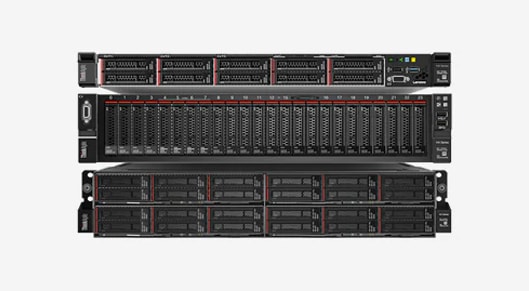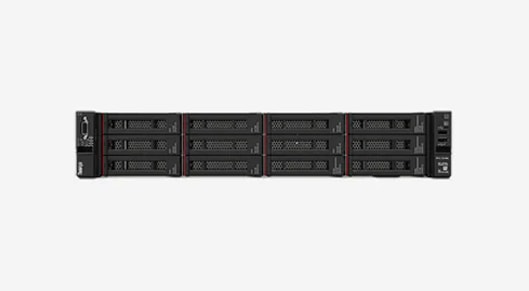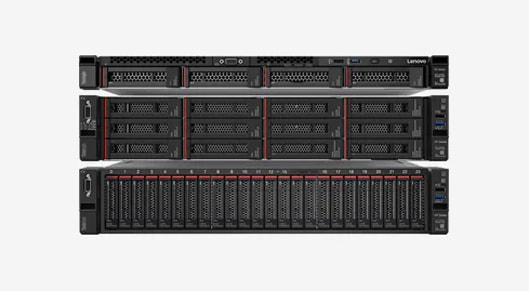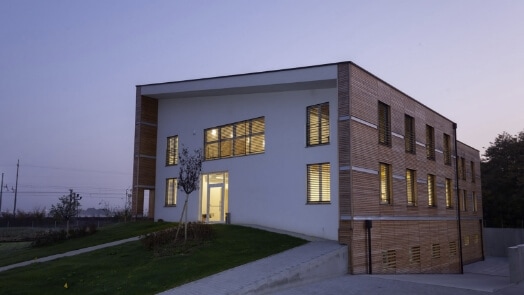
Software-Defined Infrastructure
Simplify IT and accelerate time to value
Lenovo's ThinkAgile Appliances and Certified Nodes are designed to make your life easier. ThinkAgile solutions simplify IT infrastructure and accelerate time to value, freeing you to focus on your core business.
ThinkAgile HX Series
ThinkAgile MX & SXM Series
ThinkAgile VX Series
Customer success stories
Expedient
EXE.IT
Servimed
Software Defined Infrastructure (SDI) SDI
SDI
Software-defined infrastructure (SDI) is a technology that refers to logically pooled computation, memory, storage, and networking resources that are managed by software with little human intervention.
SDI-enabled data center's are more intelligent, self-aware, self-healing, self-optimizing, self-scaling, and automated, making new service deployment times go from weeks to minutes. In other words, SDI helpsdata centeroperators focus on their business goals rather than managing infrastructure.
If you're looking for a way to improve your data center's efficiency and agility, SDI may be the answer.
As it also supplies a standardized, open platform to automate and iZntegrate IT critical functions such as backups. This way applications can specify their hardware requirements through code which makes it possible for the system automatically oversees all these needs while also improving data center agility by decreasing costs with flexible configurations per application on commodity servers. SDI allows you take advantage of private cloud or public options depending upon your need--it's completely up choosing!
The enterprise's infrastructure needs to become an SDI if it wants the best possible long run. There are reasons why keeping a traditional infrastructure may not make good business sense in today’s world.
Layers of SDI
- - Physical Infrastructure – It is the most important component of any data center. Without it, all other components are useless and can't do their job properly which results in reduced productivity for employees as well increased maintenance costs because there will always be something wrong with your company's properties no matter how hard you try to keep them up-to date!
- - Virtualization - This lies a top the physical components of an SDI architecture, where fixed-function appliances on servers are replaced with virtual machines that abstract away from hardware function. These scalable containers can be used to size up storage solutions automatically and increase its performance or cost without sacrificing any benefits from specialization per workloads' needs at hand - all while keeping full control over what gets done when!
- - Software-Defined Capabilities - The concept of software-defined computing is not new, but it's becoming more popular. This trend can be attributed to virtualized systems that abstract away from physical hardware and supply an intelligent control system for all services on these virtual resources. The most widely known form being Virtual machines which allow you run whatever operating system (or even none) within them - giving us great flexibility in how we use our computers!
- - Management Services - The management services layer will manage all infrastructure tasks needed for a guarantee that targeted SLA (Service Level Agreement) criteria are upheld as well as keep consistent high levels traffic flow across various platforms in order maximize revenue potential through elasticity strategies like greatness or scaling up/down based on demand throughout different seasons.
Who should buy an SDI?
Businesses that require high levels of agility, want to minimize infrastructure lock-in, or need to leverage best-of-breed components should consider investigating adopting a SDI like Lenovo’s offerings including ThinkAgile HX Series ThinkAgile SX Series, proper model which will fit all your needs completely.
Reasons why your Business needs SDI
- - Decouple Hardware from Software - IT infrastructure, which incorporates computing, networks, and storage, is provided as a hard and fast of virtualized services, eliminating the expenses of special-reason hardware procurement and maintenance, which reduces capital costs and will increase the usage of sources due to open-standards-primarily based totally hardware and software.
- - Easy Setup - The easy provisioning, setup and de-provisioning of computing services make it possible for IT teams to oversee their workloads with just few clicks. This improves the overall experience which can also help enhance portability on moving from one environment/location within your company or organization's data center(s).
- - High ROI - SDI is a revolutionary company that helps you save costs by relying on open standards and protocols developed in the industry rather than proprietary hardware or software. In addition, they maximize usage of your current IT assets with cloud technologies to help companies like yours get more out their investment while still being able take advantage if any future advancements come along!
- - Enable Automation - SDI platform is to automate all aspects of resources, from managing certifications and baseline requirements through monitoring their performance. This will reduce time spent on manual effort by professionals who are needed only when an issue arises or need arises for changes in infrastructure - automating every step along this process saves both money and precious human resource hours that would otherwise go towards such tasks as changing out parts around at night while users sleep.
- - Increases your Coordination and Flexibility - Software Defined Infrastructure help you work more flexibly and with the right approach. It virtualizes your IT infrastructure, andnetworkstorageservers so that suddenly there's no limit on what type or how many devices can access information at any given time!
SDI Benefits for the Businesses
Software Defined Infrastructure (SDI) enables organizations to control how IT workloads are distributed and perfected so they can maximize the value potential of theirinfrastructure deployments. Early movers in this journey should take advantage of technology like SDI, which will deliver optimum levels service delivery for customers with low latency or high performance apps as key competitive differentiation features that set them apart from competitors who haven't yet made such strategic investments into updating existing systems.
The demand for data center automation, intelligence and virtualization is growing. With its expanding scope of these technologies applied to cloud-based solutions in industries such as healthcare or government it's clear that DI will continue on top! There are reasons why software-defined infrastructure (SDI) is becoming increasingly popular. SDI can help to improve efficiency and agility, while also reducing costs. Here are the key benefits of SDI:
1 .Increased Efficiency and Agility - With SDI, you can manage your resources more effectively and respond quickly to changes in demand. This makes it easier to adapt to fluctuations in traffic or business needs.
2. Reduced Costs - SDI can help you reduce your infrastructure costs by automating tasks such as deployment, provisioning, and management. This makes it easier to manage your resources and improve ROI.
3. Improved Scalability - The cloud has been a game changer for the IT industry, providing organizations with increased scalability and flexibility. But as businesses continue to demand more from their IT infrastructure, it's becoming clear that traditional approaches to scaling are no longer sufficient. This is where software-defined infrastructure comes in.
4. Ease of Management - IT teams can now provision and check their software-defined infrastructure from a central dashboard. This is possible with the ease of use that app store like dashboards provide, so IT professionals won't have to worry about any time-consuming tasks anymore!
There are myths and misconceptions surrounding SDI. Let's dispel some of the most common ones:
1. SDI is only for Big Businesses - This couldn't be further from the truth! SDI can be used by businesses of all sizes, from SMEs to large enterprises. In fact, many small businesses are already using SDI to streamline their operations and improve efficiency.
2. SDI is Expensive - While it is true that implementing an SDI solution can be costly, the long-term benefits far outweigh the first investment. When you consider the time and money saved on data entry, storage, and retrieval, as well as the increased accuracy of information, it's easy to see# how an SDI solution can quickly pay for itself.
3. SDI is Difficult to Implement - Again, this is simply not the case. While every business is different and will have unique needs, there are off-the-shelf SDI solutions available that can be easily customized to fit your specific requirements. Plus, with the help of aprofessional service provider, the implementation process can be smooth and hassle-free.
4. SDI is only for Technical Users - Wrong! While SDI does need some technical knowledge, it is certainly not limited to IT professionals or other tech-savvy users. Thanks to the user-friendly interfaces of today's SDI solutions, even those with no# technical experience can easily learn how to use and receive help from SDI.
5. SDI is not Secure - This is one of the biggest myths about SDI. In reality, SDI is actually more secure than traditional data management methods. This is because SDI solutions typically include built-in security features, such as user authentication and data encryption, which help to protect your information from unauthorized access or theft.
SDI will revolutionize the manner future-equipped companies will plan, obtain, and manipulate infrastructure sources. It gives a unified structure that brings together legacy systems,cloud computing, and workload-centric architectures below a single, plausible roof.
SDI, they may have few tactics to pick from; they can both embody those skills with trendy answers or make use of a customizable possibility. This trendy technique permits a quick, reliable, and clean course to a software program described surroundings; however, it is able to limiting its skills with inflexible proprietary tools and processes.
A custom answer may be an extended and in-depth process; however, it includes the authority to pick, and gather the infrastructure sources primarily based totally on an enterprise’s preference.
Our Services will let you flow in the direction of an SDI surroundings — allowing you to design, implement, train, and manipulate sources that force commercial enterprise results and put together your enterprise for the future.
The traditional model of infrastructure is one in which hardware and software are tightly coupled, making it difficult to change or upgrade either without affecting the other. This can lead to costly and time-consuming IT projects, as well as inflexible systems that are unable to keep up with your pace of business change.
Software-defined infrastructure (SDI) is a new approach that seeks to decouple hardware and software, giving organizations greater flexibility and agility in how they deploy and manage their IT resources. SDI does this by abstracting away the underlying hardware and presenting it as a pool of resources that can be dynamically distributed to meet all your changing needs for businesses.

Need more information?
Fill out this form so a Lenovo representative can contact you.







